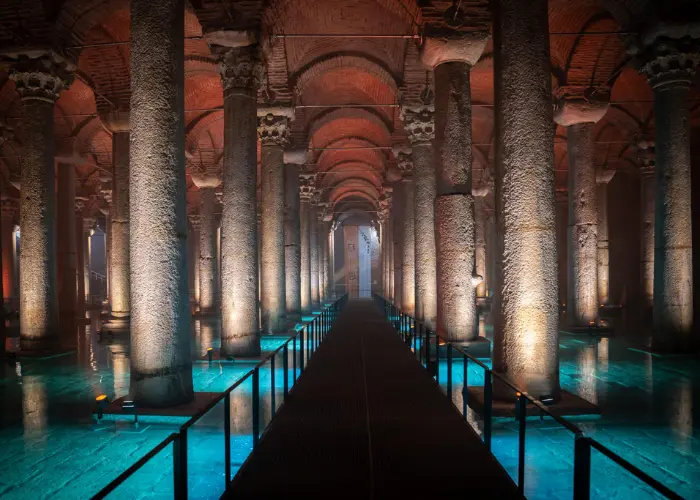Beneath the bustling streets of modern-day Istanbul lies an extraordinary relic of Constantinople’s past – the Basilica Cistern, a colossal underground water storage facility built during the reign of the Byzantine Emperor Justinian I. This ancient engineering marvel, with its eerily atmospheric ambiance and historical significance, has long captivated the imagination of visitors and historians alike.
The Basilica Cistern: A Subterranean Masterpiece
The Basilica Cistern, or Cisterna Basilica, is the largest of several hundred ancient cisterns that once lay beneath the Byzantine capital. Constructed in the 6th century AD, this subterranean reservoir was designed to provide a reliable water supply to the Great Palace of Constantinople and other important buildings on the city’s First Hill.

The Forgotten Basilica
Prior to the construction of the cistern, this site was occupied by a grand public square and a large basilica, dating back to the 3rd and 4th centuries. The original basilica, which served as a commercial, legal, and artistic center, was destroyed by a fire in 476 and later rebuilt by the Roman statesman Illus.
Justinian’s Architectural Marvel
The Basilica Cistern was commissioned by Emperor Justinian I after the devastating Nika riots of 532, which had ravaged the city. According to historical accounts, the construction involved the labor of 7,000 slaves, a testament to the sheer scale and ambition of the project.
Architectural Splendor and Intricate Design

The Basilica Cistern is a true marvel of Byzantine engineering. Spanning an area of 9,800 square meters (105,500 square feet), it is supported by a forest of 336 marble columns, each standing 9 meters (30 feet) tall. The columns, many of which feature intricate carvings and base decorations, were repurposed from earlier structures, showcasing the architectural ingenuity of the builders.
A Water Filtration System and Beyond
The cistern’s primary function was to serve as a water filtration system, providing a reliable source of fresh water to the Great Palace and other important buildings. However, it also played a role in the city’s defense, as the stored water could be used in times of siege or emergency.
The Enigmatic Medusa Heads

One of the most captivating features of the Basilica Cistern is the presence of two inverted Medusa heads, which serve as the base for a pair of columns. The origins and significance of these mysterious carvings have long been the subject of speculation and debate among historians and archaeologists.
A Forgotten Treasure Rediscovered
After the fall of Constantinople to the Ottomans in 1453, the Basilica Cistern fell into disrepair and was largely forgotten for centuries. It was not until the 19th century that the cistern was rediscovered and recognized for its historical and architectural importance.
Conclusion
The Basilica Cistern stands as a testament to the engineering prowess and cultural richness of the Byzantine Empire. This subterranean wonder, with its eerie beauty and enduring mysteries, continues to captivate and inspire visitors from around the world, offering a unique glimpse into Constantinople’s glorious past. As we explore the echoes of this ancient structure, we are reminded of the remarkable feats of human ingenuity and the enduring power of architectural marvels to transcend time and capture the imagination.
